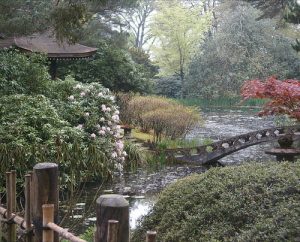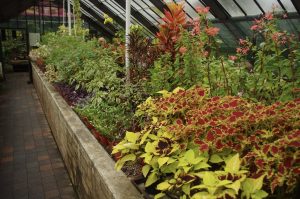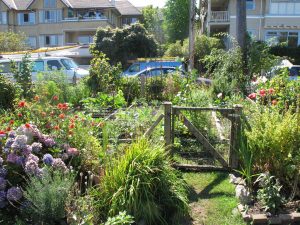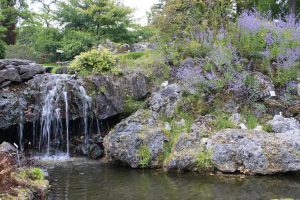Gardens: Natural Art
Alan Verdu
Preface:
Hi, my name is Alan Verdu, and this portfolio is called Gardens: Natural Art. The licensing I will be using is CC BY 4.0.
Introduction:
My main focus is the existence and power of gardening as an art form, and specifically the way it helps bring us closer to nature. Gardening is an art that has existed for thousands of years, being present in every major civilization. Even in ancient times, the Hanging Gardens of Babylon were considered one of the Seven Wonders of the world. Gardening as an art form can help foment a closer relationship to nature, as well as benefit the community as a whole. In order to highlight this better, I have focused on three distinct forms of gardening in this portfolio. These are traditional Japanese gardens, botanical gardens, and community gardens.
Themes: Gardening as Art
Gardening as an art, enables a closer understanding and connection to nature, allowing us a return to our roots in a way. Society often can feel very stifling, and gardens can help provide a place where it is possible to take a break from it all. Gardening as an art form also serves as a way to improve the community. Gardens help break up the monotony of a city or town by adding a splash of color, and a location where it is possible to admire nature and relax. They also provide more than just aesthetic and mental benefits, as edible plants can be grown, helping alleviate the needs of the community.
Analysis:
Each of the three images I selected showcases a different forms of gardening.

“Japanese garden.” by practicalowl is licensed under CC BY-NC-SA 2.0
This first image is of a traditional Japanese garden. This style of garden originated over a thousand years ago. In Japanese culture, creating a garden is considered one of the highest possible forms of art, next to calligraphy and ink-painting, and it is seen as a three-dimensional expression of philosophy. Unique thought is put into the creation of Japanese gardens in order to present an image of an ancient landscape, disconnected from the current reality. They manage to achieve this aesthetic through the use of worn materials and plants that help highlight the natural landscape, along with the avoidance of modern materials and objects.
Within these gardens there is a sense of timelessness and a feel for the power of nature. The peaceful environment of a Japanese garden, alongside its serene beauty, foments relaxation and a feeling of connection to the surrounding nature, making it an ideal location for quiet contemplation or meditation. There are many of them that are popular tourist locations, and for good reason: there are few places that can bring you closer to nature while being relatively close to an urban setting.

“Botanic Gardens Glasgow” by dvdbramhall is licensed under CC BY-NC-ND 2.0
This second image demonstrates an example of a botanical garden. These are gardens that are dedicated to the display of a wide variety of plants, usually for conservation or educational purposes, but also to display beautiful varieties of plants. Similar concepts can be found going all the way back to ancient Egypt, China, or Mesopotamia, such as the Hanging Gardens of Babylon. Botanical gardens surged with the European Renaissance, as part of universities and medical schools. They later grew in popularity with the European nobility as a way to showcase the beautiful variety of flora that could be found in faraway lands.
Due to the great variety of plants that form part of a botanical garden, usually of exotic nature, they are usually filled with all sorts of vivid colors, beautiful shapes, and delicious scents, reminding us of the beauty that can be found within nature. Today, they also provide an important role in research, conservation, and education. Most botanical gardens provide services to accommodate visitors, such as educational or artistic displays, or tours. They have become a popular tourist attraction, with an estimated 1800 botanical gardens worldwide, and over 300 million visitors every year.

“garden” by dorywithserifs is licensed under CC BY-NC-SA 2.0
This third image I selected depicts a community garden. This variety of garden is named as such because it is managed by the local community, each member putting in their own effort, and each benefiting from it. The first gardens to ever exist, back when humanity first started practicing agriculture, but before it became large-scale, were likely similar to this category of garden. Community gardens are common all throughout the world, and while they are generally more humble in appearance than the previous two examples of gardens discussed, they are beautiful, as evidenced by this image.
This kind of garden allows a community a space where it is possible to relax, and enjoy themselves, as well as providing an opportunity for physical exercise. Additionally, community gardens also help provide a sustainable source of healthy food for the community, improving the well-being of its members, and providing a vital resource for those stuck in food deserts. In this way, community gardens are an incredible boon, improving the mental and physical health of the community members, while also improving the appearance of the area.
One of the garden varieties I was also interested in are rock gardens, such as the one depicted in the following image.

“The Rock Garden” by georgemoga is licensed under CC BY-NC 2.0
Rock gardens such as this one are rather unique in that it is not just the plants that are the focus of the garden, but, as the name implies, these gardens all involve rocks as a major part of their composition. Rock gardens can be further divided into two categories: eastern and western. Eastern rock gardens can be traced back to early Chinese and Japanese gardens, and are somewhat similar to the Japanese gardens discussed earlier, with the obvious distinction that there is more of an emphasis on the rocks. Western rock gardens are also known as alpine gardens, and are much more recent, having took off in popularity in Europe during the Victorian era. These gardens usually feature alpine plants, which is where their name comes from.
Whichever tradition a rock garden belongs too, they have some chief characteristics in common. The first of these has already been discussed, and it is the requirement that rocks form a major part of the composition of the garden. The second is that the plants used are generally small and short, complementing and giving more attention to the stone masses. Beyond that, there is a lot of variety in what a rock garden actually looks like, with some opting to have the stones stand out and be the center of attention, and others, like the image above, go for a more natural look, imitating natural rock formations.
Rock gardens bring a bit of nature into the heart of civilization, and tend to be peaceful areas in which it is possible to relax and enjoy nature. They make great areas for relaxed walks or a bit of exercise, letting people forget about their worries and feel healthy. There is a simple beauty to them, and it is definitely worth visiting one if you happen to have one nearby.
Application: The Duality of Form and Function
The importance of gardens is undeniable. They are one of the most effective art forms when it comes to deepening our connection with the environment, putting us in direct contact with nature. All three of the different varieties of gardens highlighted here are similar in that, while providing a beautiful environment to enjoy, they all additionally provide some form of tangible benefit to the community, whether that be through presenting a space to relax and improve our connection with nature, allowing for the conservation of nature, or feeding the local community. It is this duality of form and function that makes gardening unique as an art form. Increasing the number of gardens would be a net positive for the world.
There are multiple examples of the positive impacts of gardens, but one that does the best job supporting my points is the garden maintained by Ron Finley in South Central Los Angeles, an area that has little to no access to affordable or nutritious food, also known as a food desert. Lack of access resulted in his local community having very poor health, with extremely high levels of diabetes and otherwise preventable diseases. Sick of this, Ron Finley decided to use vacant lots the city owned to plant fresh fruits and vegetables, with the hope that this would help improve the health of his community. After a short legal battle with the city, he obtained the permission of the city to plant a garden.
The community garden he created was wildly successful, and he’s gone on to create several more. Additionally he also teaches others how to create their own community gardens. The TED talk he gave on his story has over two million views. He considers himself a “gangsta gardener,” saying that he wants to redefine what it means to be “gangsta” into something positive for the community. In his own words: “I’m an artist. Gardening is my graffiti. I grow my art. Just like a graffiti artist, where they beautify walls, me, I beautify lawns, parkways. I use the garden, the soil, like it’s a piece of cloth, and the plants and the trees, that’s my embellishment for that cloth. You’d be surprised what the soil could do if you let it be your canvas.” He is the perfect example of the power of gardening as an art form.
There are many different kinds of gardens that can be found on this planet, fulfilling all sorts of different roles, each possessing its own unique aesthetic. In this portfolio I chose to showcase Japanese gardens, botanical gardens, and community gardens. There were several other styles of gardens that I had initially considered, but I eventually settled on those three varieties of gardens described above because I felt that my selection provided an accurate representation of the width of different forms and functions that gardens can take on.

